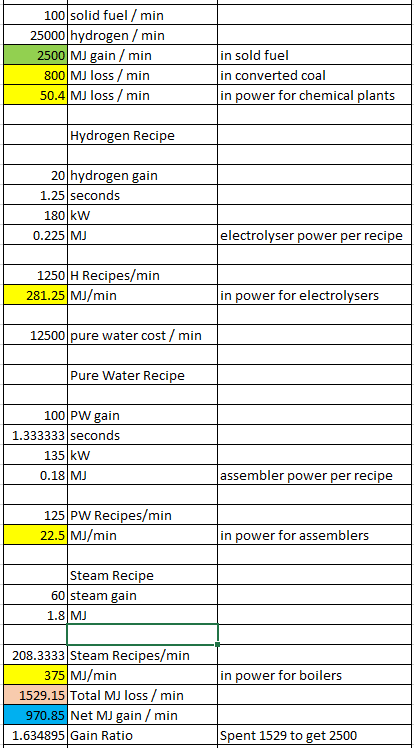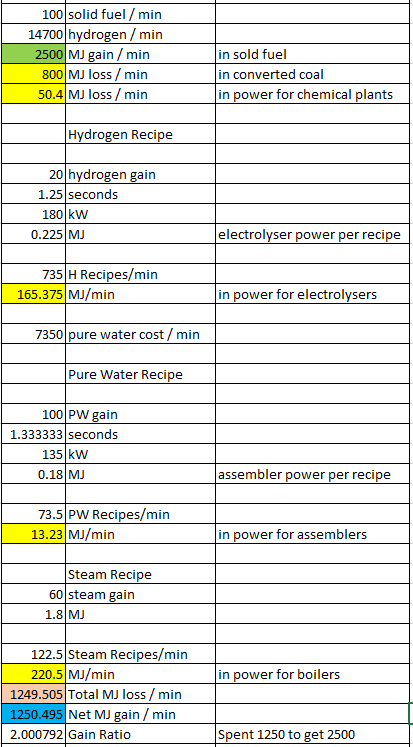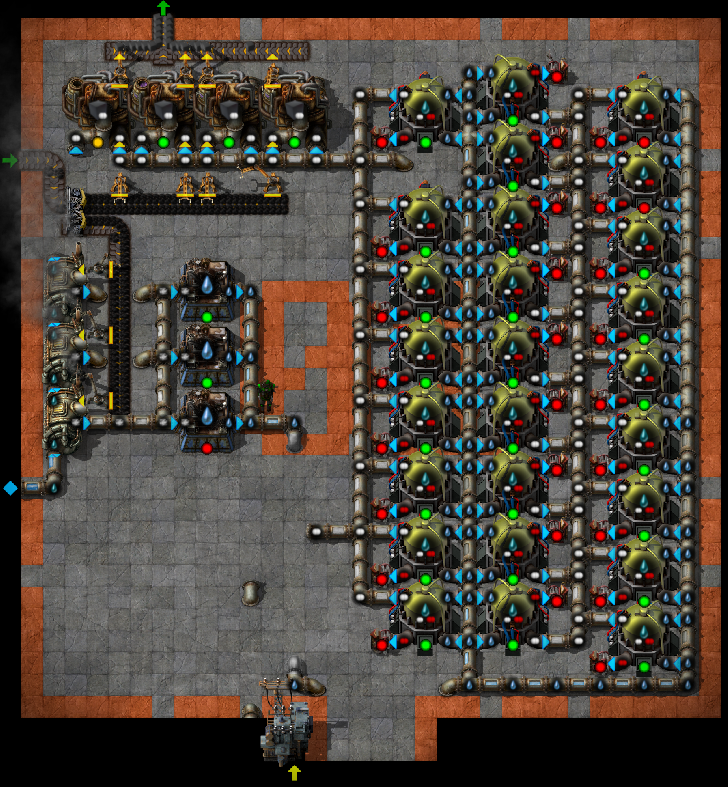Bob, please read to the end. I finished the calculations for the solid fuel conversions and compared the figures WITH and WITHOUT the pure water requirement.
nagapito wrote:All your math seems is a little off.
You converted (8*73)584MJ into (25*73)1825 MJ, gaining 1241 MJ in the process. If you used 252 MJ to do the conversion, then your gain is 1241-252= 989MJ.
That is an 169% gain in energy (989/584). That is a bit too strong!
A more acceptable end value would be something like 120%-130% (700MJ-759MJ). So, the whole process should consume 1825(solid fuel)-584(coal)-750(desired gain) = 491 MJ, almost the double!
When coming up with the 1.69 gain, I think we've all screwed up on the math here.
You pointed out that this is from 989/584 right?
But 989 is the net gain and 584 was the original value of the coal.
It doesn't make sense to divide the net gain by the original value.
To determine your increase ratio over the process, you have to take the total end value and divide it by the total amount spent (what you give up to get the end product).
So in the previous example, that would be 1825/(584+252) = 2.18x
This is also time limited based on how many machines you have working on the conversion. It is also not recursive since you can't run solid fuel back into the system to perpetuate this gain (this is good).
This means that (with time) you can convert your coal to a more efficient fuel by getting 2.18x (as measured roughly) the energy output from the new fuel, accounting for conversion costs.
And this is when electrolysers use NORMAL water.
However... I have new calculations for when electrolysers require PURE water. It is not nearly as rosy. But it is still somewhat good.
The TL;DR of this is that by requiring pure water, your NET GAINS are cut pretty much in half.
My calculations are for converting 100 coal into solid fuel inside one minute.
Four chemical plants will do this.
A chemical plant has a crafting speed of 1.25
The solid fuel recipe is 3 seconds and requires 1 coal and 250 hydrogen.
That means 1/3 solid fuel per second or 1 1/3 solid fuel with four machines.
That's 80 per minute.
Multiply this by the crafting speed to get 100 per minute.
The total hydrogen requirement would be 25000 per minute.
100 solid fuel has 2500MJ. This is the total gain per minute.
Now we have to break down the total MJ cost per minute.
First, we have an 800MJ loss due to the coal being converted.
Chemical plants use 210kW of power.
0.21MJ per second (x60) for four machines = 50.4MJ per minute for the chemical plants.
Next, we work out the cost of the hydrogen. We know it requires 25,000 total, and the recipe produces 20.
That's 1250 recipes crafted per minute.
The electrolyser's crafting speed is 0.8 so each recipe takes 1.25 seconds.
The electrolyser's energy use is 180kW and if run for 1.25 seconds that's 0.225MJ per recipe.
Total hydrogen cost is then 281.25MJ to operate the electrolysers.
Next up is the pure water assembler cost. The hydrogen recipe requires 10 pure water to make 20 hydrogen.
So 25000 hydrogen needs 12500 pure water.
Pure water is crafted 100 at a time. That means there are 125 recipes run.
The blue assemblers have a crafting speed of 0.75 which means 1.333 seconds per recipe.
Blue assemblers use 135kW of power to run, so that is 0.18MJ per recipe.
125 recipes x 0.18MJ = 22.5MJ per minute total.
Lastly, we have to calculate the cost of the steam.
Boilers presumably produce 60 steam per second.
Boilers use 1.8MW to run, which means 1.8MJ is consumed to produce 60 steam.
12500 steam (total) divided by 60 = 208 one-second "recipes" of steam.
1.8MJ per recipe = 375MJ per minute total.
This means the Grand Total cost per minute for this operation is:
800 (for the coal lost)
50.4 (to run the chemical plants)
281.25 (to run the electrolysers)
22.5 (to run the assemblers)
375 (to run the boilers)
= 1529.15 total cost.
The gain, again, is 2500MJ.
The final calculation, then, is to take the total gain (2500) divided by the total loss (1529.15).
This comes to 1.63x
Compare this to the method NOT requiring pure water, which was a 2.18x (as measured roughly).
Now, I'll argue strongly (again) that this should NOT be any less than that. Mostly because of the massive coal cost for operating a coal-fired setup for many hours as opposed to a solid fuel setup. The new boilers use a LOT more coal than they used to, and it's going to chew through that initial coal patch fairly quickly. Allowing the player to give themselves a 63% increase (not 163%) by running their coal through this rather complex (for the early game) setup, is not overpowered in my opinion. Also remember it requires several green-science technologies to be researched before you can achieve it.
When running the actual numbers for the OLD system (not needing pure water), you can remove 397.5MJ from the cost. That produces 2500MJ at a cost of 1131.65MJ.
Interestingly, this means the gain is 2.21x mathematically, which is VERY close to my measured 2.18x
Considering 2.21x increase WITHOUT pure water and comparing it to 1.63x WITH pure water, we can conclude the following:
This is a 121% increase compared to 63% increase.
That means the NET GAIN is 1.92x MORE without the pure water requirement. Nearly double.
So requiring pure water HALVES the advantage of this system. A pretty serious hit. Survivable? Sure. Annoying? Definitely.
My recommendations? Well, through the magic of spreadsheets, we can actually adjust the HYDROGEN requirement for your solid fuel recipe. Currently, it's 250.
But if we require pure water, that puts the net gain at 63%.
I propose forcing the net gain to be 100%. To do this, all you would have to do is adjust the hydrogen cost of solid fuel to 147 per recipe instead of 250.
With 147 hydrogen per solid fuel, and requiring pure water in the electrolysis, you have a
precise (2.0008x) doubling of your total MJ by running your coal through this process. And again, because the boilers eat coal so quickly, I think it's a fair goal to give the player a doubling of their efficiency by setting up this process, thus easing off the demand on the coal patch after a few hours of play. Considering how long it'll be before solars come, I think that's a fair deal.
Or likely more preferable (for round numbers) would be 150 hydrogen per recipe, which still gives you 1.987x gains.




